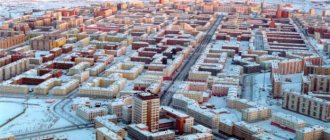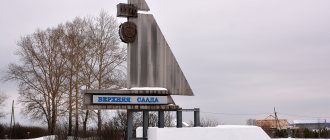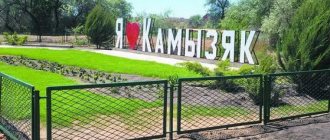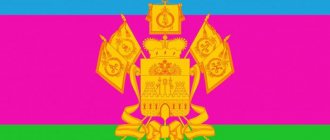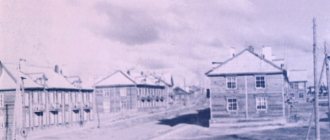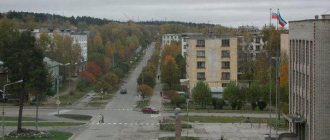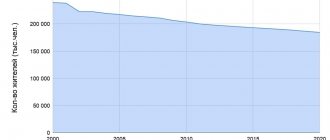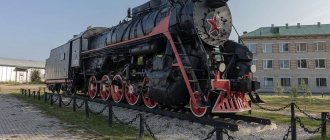Geography
58.083, 54.673, city of Vereshchagino (Perm region)
City of Vereshchagino
occupies a very advantageous geographical position.
Moscow
–
Vladivostok
railway line passes through it .
Today the territory of the Vereshchaginsky district
is
1621 sq.
km .
13 rural administrations and 182 settlements
in the district .
Lysva River
, flowing through the territory of the region, divides it almost in half. From west to east it stretches for 75 km, from north to south – 37 km.
The area borders the Republic of Udmurtia
, as well as with
Sivinsky
,
Karagaisky
,
Nytvensky
and
Ochersky
districts.
Vereshchagino
(Perm region)
OKATO code:
57212501
Founded:
1898
Urban-type settlement since:
1928
City since:
1942 City of regional subordination
Center:
Vereshchaginsky district
The city was formerly called:
| Voznesenskaya | 1915 |
| Telephone code (reference phone) | |
| 34254***** | 22-2-92 |
Deviation from Moscow time, hours:
2
Geographic latitude:
58°04′
Geographic longitude:
54°39′
Altitude above sea level, meters:
220 Sunrise and sunset times of the Sun and Moon in the city of Vereshchagino
Climate
Weather in the city for the next 3 days
The climate of the Vereshchaginsky district is temperate continental, favorable for the cultivation of many agricultural crops. Winter here is usually snowy and long; Summers are short, moderately warm. The average annual air temperature is about +1.3C*. At the same time, the average temperature in July, as the warmest month of the year, is +17.7C*, and in January, as the coldest, -15.6C*.
The winds in the region are mostly southern and southwestern. The greatest amount of precipitation occurs in July–August, the least in February–March. In August–September there are often fogs. Stable snow cover in the area appears in late October - early November, usually after the onset of frost. The territory of the Vereshchaginsky district is located in a zone of thunderstorm activity, where thunderstorms are possible not only in summer, but also in winter. In general, the climate of the Vereshchaginsky district allows for the successful development of various branches of agriculture, including horticulture. The climate is also favorable for forestry.
Monument to the steam locomotive "FED"
The unique monument to the steam locomotive "FED" is located on Karl Marx Street and is dedicated to railway drivers. It was difficult for the pioneers not only to build tracks, but also to launch the first locomotives. The installed locomotive is a thank you to those drivers who dedicated their lives to the construction of the all-Union railway.
Foundation of the city of Vereshchagino
Events of the late 19th century changed life in the Perm region. The main one was the construction of the railway.
In 1894, the Ministry of Railways and Communications decided to build the Perm-Kotlas railway. The main purpose of its construction was to give Siberian grain cargoes access to the foreign market not only through the Baltic ports, but also the Northern Dvina (Arkhangelsk), and in addition to favor the development of the economy of the Urals. It was built with funds from the treasury and in a hurry.
According to the initial project, a route was provided consisting of nine distances: Perm - Shabunichi - Nytva - Ocher - Klenovka - Debesy - Balezino - Glazov - Vyatka - Kotlas. The control of the second distance was planned to be located in Ocher, where it was planned to build a large station, and in the area of the local hospital - a station and depot. The construction managers of the second distance included: its chief - engineer A.R. Pletzer, process engineer I.F. Razmanit, engineer A.V. Stulapov, technicians L.M. Nikolaenko, E.V. Peshek and P.P. Esaulov.
The construction of the road, which began in 1895, employed a huge number of immigrant workers. According to an agreement with the contractor, they traveled from the villages of Vyatka, Perm, Kazan and Kaluga provinces. These were peasants - otkhodniks from the poor, i.e. those who did not engage in arable farming. Tempted, in their opinion, by a “good price,” they went to excavation work, preparing sleepers and other work.
In the area where the new station was being built, there was a treeless swampy hill between the neighboring villages of Verkhnee and Nizhneye Gubanovo. A little further away there was a third village - Sergeevka. The workers called this hill Bald Mountain.
The builders settled here in a “gypsy camp”, arriving on their horses, with their families and household belongings. They slept on carts or under them. During the day, men dug the earth, women took it to the indicated place, cooked food, and teenagers nursed infants. Life, work and working conditions were almost hard labor, and the pay was negligible. However, crop failures in the 90s and famine in the villages kept the peasants here.
Construction was completed four years after it began, and the first passage through the Ocherskaya station took place on January 1, 1899. A little over a month later, on February 8, the Kama Railway Bridge was opened to through traffic. The Perm - Kotlas railway was connected to the previously built Perm - Tyumen line, running from Perm to Yekaterinburg along the Gornozavodskaya branch. Thus, Siberia received another outlet to the central provinces of Russia.
However, the new road turned out to be technically imperfect, despite the large number of embankments and excavations. Soon after its commissioning, it was necessary to begin the reconstruction of some of the most difficult sections.
The railroad became a place of work for many local residents and a place of initiation for visiting engineers. The local museum houses exhibits that reflect the spirit of that time, and are still in use. These are telephone, telegraph, letter-printing apparatus, a locomotive speedometer, a Morse sound apparatus, signal lights, and railway traffic lights. All of them were donated to the museum by the honorary citizen of the city of Vereshchagino N.N. Prozorov.
The Ocherskaya station was opened on the railway; the station's railway station complex was built in 1913. Until 1916, the station managed to acquire the names Gubanovo (after the name of a nearby village), Lysaya Gora and Voznesenskaya (after the name of the volost). The station was renamed after a visit by battle painter Vasily Vereshchagin. Vasily Vasilyevich made a stop at the station on his way to the Far East for the Russo-Japanese War. He died in the Battle of Port Arthur as a result of an explosion on the battleship Petropavlovsk on March 31, 1904. In memory of the artist’s last journey, the railway station was named Vereshchagino. It was April 18, 1916. A bust of the great artist was installed near the station building.
Old
Despite the fact that there are abandoned enterprises dating back to Soviet times, in which the city seems frozen. We met an old Moskvich on the street. Judging by its appearance, it is still running.
There are old rides for kids on the playground. There are many old, but still solid and residential wooden houses. Also our attention was attracted by a small wooden well.
There is a small bench nearby. Perhaps local residents collect spring water here. No one was passing by, so there was no one to ask. A small bucket is carefully hung from above.
This ended our little excursion and we went back.
Have you been to Vereshchagino and what did you like there? Write in the comments.
Story
According to archaeological research, the settlement of the Kama region by people began approximately 75 thousand years ago. Its first inhabitants - the ancient ancestors of the present-day Komi-Permyaks and Udmurts - settled in the northern part of the territories of the present Perm region, and the forested basin of our Lysva remained deserted for a long time.
According to the results of the first detailed census of all settlements carried out in the Kama region in 1579, in the territory of the current Vereshchaginsky district, the census workers did not indicate a single, any significant settlement. The main wave of population came after 1666. It was associated with the split of the Russian Orthodox Church and the brutal persecution of supporters of the old faith.
In 1701, Peter I, in addition to those already existing, granted the Stroganov barons vast expanses of land along the Obva, Inva, and Kose rivers. Then the territory of the future Vereshchaginsky district finally became part of the Stroganov estate. In 1759, the Stroganovs founded an iron-making plant in the Ocher River tract, and in 1819, the Pavlovsk sheet-rolling plant.
Huge forest areas (forest dachas) were assigned to the factories, where serfs prepared charcoal for metallurgical furnaces, and also cooked resin and tar.
Part of the territory of the future Vereshchaginsky district was also part of the forest dacha. The Strogoths sought to increase their wealth in every possible way, and the construction of dams for flour mills began on the Lysva River. With the construction of mills, new villages were founded. This is how the village of Novy Posad arose (in the old days, settlements were often called posads), and the village of Lysvenka, which stood upstream of the river, was called Stary Posad, and by this name it is known to us now. At the end of the 18th century, a large brick Orthodox church was built in Novy Posad. After which the village received the status of a village and a new name - Voznesenskoye.
Until 1924, the village of Voznesenskoye was the center of the large volost of the same name in the Okhansky district of the Perm province. The Voznesenskaya volost later included the Gubanovskaya land community, which later became the territory of the city of Vereshchagino. The neighbors of Voznesensky volost were Sepychevskaya, Putinskaya and Staro-Putinskaya (Denisovo) volosts.
As a result of the Zemstvo reform of 1864, provincial and district zemstvo assemblies and corresponding zemstvo councils were created, which became bodies of local self-government. Thus, the emergence in our time of the Zemsky District Assembly is a return to a well-forgotten old way of solving local problems.
Despite all the complexity of development, the zemstvo movement intensified by the end of the 80s of the 19th century. Among others, Zemstvo institutions were involved in the development of school affairs. In the Perm region during these years, schools were opened in Putino, Sepych, Voznesensky. School No. 1 in Vereshchagino
In 1894, the Ministry of Railways decided to build the Perm-Kotlas railway. According to the initial project, the route was planned to pass through Ocher, where it was planned to build a large station, train station and depot. However, the bureaucratic administration of the Ochersky plant showed no interest in the railway. Their reluctance to give up the lands of Count Stroganov for the road led to the fact that the highway from Perm after the Shabunichi station was directed north and went through “state lands.”
24 kilometers north of Ocher, the construction of a large station was planned, which, in accordance with the original project, was called Ocherskaya for some time (opened in 1899), named after the river. Wow.
In 1898, a wooden one-story station building was built here, and this date is considered to be the time of the founding of the future city of Vereshchagino. In 1902, the four-year construction of a typical locomotive depot for that time was completed (now the track machine repair plant is the largest enterprise in the region in terms of number of employees).
In 1904, the new station was renamed Voznesenskaya station after the volost center. In the same year, while traveling to the eastern front, the battle painter V.V. made an emergency stop here. Vereshchagin. On April 30, 1915, Voznesenskaya station was renamed Vereshchagino station in honor of the 10th anniversary of the death of the artist V.V. Vereshchagin (1842-1904). On January 1, 1924, as a result of administrative-territorial division, the Vereshchaginsky district was formed from the Voznesenskaya volost, which included 10 village councils, and the village of Vereshchagino became its regional center. At that time its area was 390 square meters. km, and the population is 10 thousand people. On June 19, 1942, by the Decree of the Presidium of the Supreme Soviet of the RSFSR, the workers' settlement was given the status of a city.
The Western Gate of the Urals is the name of the Vereshchagino station, located in the south-eastern part of the region at the intersection of the Moscow-Vladivostok railway and the Siva-Bolshaya Sosnova inter-district highway.
(The text was prepared based on the book “The Affairs and People of the Vereshchagin Land. A Book about Contemporaries” / published by T.I. Pestov. Vereshchagino, 2004. 49 p.: ill. The book uses materials from local historian V.G. Melchakov, Honorary citizen of Vereshchagino)
Cities
If we consider the population in the Perm Territory not in general, but specifically by settlements, by main cities, then here is the data provided by Rosstat for the period 2022:
- Perm - 1,059,934 people.
- Berezniki – 141.276.
- Usolye city – 6368.
- Gornozavodsk - 11274.
- Kungur city – 65.824.
- Tchaikovsky urban district - 104.306.
- The population of the city of Kudymkar is 30,904.
- Vereshchagino – 21.648.
- Kiesel - 14.162.
- Dobryanka – 32.304.
- City of Chusovoy – 44.185.
- Kudymkar – 30.904.
- Gubakha – 19.472.
- Krasnovishersk – 15.023.
- Chernushka – 32.954.
- Chusovoy municipal district has a population of 66,381, while the city itself is 44,185.
- Oktyabrsky Municipal District - 27.139.
- Wasp – 20.899.
Data for 2010
Population
The population of the city is 22.8 thousand people.
The share of the urban population in the number of residents of the district is 62.7% (29.3 thousand people). Thus, the district is dominated by city dwellers, 82.3% of whom live in the city of Vereshchagino (51.7% of district residents). The gender and age structure of the city's population is characterized by a predominance of the female population (54.0%) over the male population (46.0%). More than half of the city’s employed population is engaged in mechanical engineering (32.3%) and its light industry (27.7%). Population by year (thousands of inhabitants)
| 1931 | 6.0 | 1989 | 24.1 | 2001 | 25.2 | 2008 | 22.8 |
| 1959 | 22.9 | 1992 | 24.9 | 2003 | 22.8 | 2010 | 22.8 |
| 1967 | 22 | 1996 | 24.9 | 2005 | 22.8 | ||
| 1970 | 23.6 | 1998 | 24.9 | 2006 | 22.7 | ||
| 1979 | 22.3 | 2000 | 25.1 | 2007 | 22.6 |
Ethnic composition
The ethnic composition of the region looks like this in 2022:
- Russians – 80.87%.
- Tatars – 5.54%.
- Komi-Permyaks – 4.56%.
- Bashkirs - 1.32%.
- Udmurts - 0.73%.
- Belarusians – 1.1%.
- Ukrainians – 2.4%.
- Germans – 1.3%.
- Azerbaijanis – 0.03%.
- Armenians – 0.08%.
- Chuvash – 0.51%.
- Uzbeks – 0.03%.
- Mari - 0.19%.
- And others in a small percentage.
Notable natives and residents
During the Great Patriotic War of 1941-1945. the Vereshchagin land gave the Motherland five Heroes of the Soviet Union and one full holder of the Order of Glory.
- Sapper Ivan Petrovich Kadochnikov.
Born on July 19, 1911 in the village of Vederniki, present-day Kuketsky village council. From 1935 to 1941 he worked as an electric welder in the city of Kamensk-Uralsky, Sverdlovsk region. He spent the entire war on front roads as part of the 86th Separate Guards Engineer Battalion. Participated in the battles of Stalingrad and Orel. Cherngov, liberated Belarus and Poland. He ended the war in Berlin. Corporal Kadochnikov accomplished his feat of arms in the fall of 1943 when advancing Soviet troops crossed a large water barrier - the Dnieper River. His award sheet says: “Within three days, comrade. Kadochnikov continuously, almost without rest, under enemy fire, worked on rafts and ferries as an accompanying oarsman, devoting all his strength to ensuring the crossing of manpower, ammunition, food and the wounded.” He was awarded the title of Hero of the Soviet Union on January 15, 1944. After the end of the war, I.P. Kadochnikov lived and worked in the city of Baranovichi, Brest region of Belarus, where he died and was buried in 1967.
- Artilleryman Ivan Georgievich Kislukhin.
Born in the village of Komary in 1919. After graduating from the Zyukai Agricultural College, he worked as a local mechanic at the Kochevsky MTS of the Komi-Permyak Autonomous Okrug. In 1939 he was drafted into the Red Army. He served in the Far East. During the Great Patriotic War, after graduating from college, he was commander of an artillery battery. Lieutenant Kislukhin accomplished his feat on August 20, 1944, liberating Lithuanian soil. The personnel of his battery won a long, unequal battle with fascist tanks and infantry on the Sheshupa River bordering East Prussia, without losing their positions. Lieutenant Kislukhin, who was adjusting the fire, was mortally wounded. He was awarded the title of Hero of the Soviet Union posthumously on March 24, 1945. Subsequently, the ashes of our courageous fellow countryman were transferred to the cemetery of the Lithuanian city of Kudirkos-Naumetis.
- Sapper Evgeniy Mikhailovich Obukhov
Carried out the crossing of our advancing troops across the Dnieper south of Kyiv. Showing dedication and courage, he transported hundreds of soldiers, a lot of weapons and ammunition in his boat. Under fire and bombing, working day and night, he made 100 flights. The title of Hero of the Soviet Union E.M. Obukhov was awarded on January 10, 1944. And he died in battles on Pskov soil. Unfortunately, the district museum does not even have a photograph of E.M. Obukhov.
- Tank driver Mikhail Danilovich Sanachev.
Born in 1916 in the village of Petukhi, Vereshchaginsky district. In 1939, he voluntarily joined the Red Army. Graduated from a tank school. Was accepted into the ranks of the party. Since the first war, M.D. Sanachev has been at the front. He was a political instructor, then commander of a tank company of the 51st Tank Brigade. Our fellow countryman accomplished his feat on Ukrainian soil, in the battles for the liberation of the city of Uman. Here his crew knocked out seven fascist tanks. He was awarded the title of Hero of the Soviet Union on September 13, 1944. After the end of the war, Colonel Sanachev M.D. continued to serve in the Soviet Army. He is currently retired and lives in the Moscow region.
- Paratrooper Viktor Stepanovich Shatrov.
Born in 1914 in the village of Nosyata, present-day Krivchanovsky village council. In 1936 he was drafted into the Red Army. He took part in battles with Japanese militarists near Lake Khasan, where he was awarded the Order of the Red Banner for his heroism. In battles on the fronts of the Great Patriotic War since October 1941. He served in the airborne forces and commanded a battalion. Awarded many orders and medals. On February 22, 1944 he was awarded the title of Hero of the Soviet Union. After the end of the war, Colonel Shatrov V.S. continued to serve in the Soviet Army until 1958. Then he lived in the city of Kharkov, worked at one of the enterprises. Recently he lived in the town of Lyubertsy near Moscow, where he died and was buried several years ago.
- Full holder of the Order of Glory Anatoly Pavlovich Pyankov.
Born in 1925 in the former village of Malye Sosnyata, present-day Borodulinsky village council. Before the start of the war, he completed tractor driving courses and worked at Putin’s MTS. He volunteered for the front in 1943. Participated in the liberation of Belarus and the Baltic states. He was the commander of a submachine gunner squad and was wounded several times in battle. In the fall of 1945, A.P. Pyankov was demobilized, worked as a machine operator, foreman of the tractor detachment of the Putin MTS, and then headed the Agricultural Equipment service station. In 1950, the Vereshchaginsky district military commissar presented A.P. Pyankov with an award that had been looking for him since December 1944. For the heroism shown in battles then, he was awarded the third Order of Glory, 1st degree. In 1964, A.P. Pyankov moved with his family to the Ilyinsky district, where until his retirement he worked as a local mechanic at the Dzerzhinsky collective farm.
Honorary citizens of the city of Vereshchagino and Vereshchaginsky district
- Alikina Natalya Vasilievna
. (August 27, 1920 – June 27, 2002) The title “Honorary Citizen of the City of Vereshchagino” was awarded by the decision of the Zemsky Assembly of the Vereshchaginsky District on October 23, 1997. For many years of conscientious work in health authorities and active participation in the public life of the city.
- Voronenko Nadezhda Spiridonovna
. (August 23, 1917 – July 10, 1992) The title “Honorary Citizen of the City of Vereshchagino” was awarded by the decision of the executive committee of the Vereshchaginsky City Council of People's Deputies on November 26, 1987. For services to the cultural development of the city and active social activities.
- Guseva Meta Vilhelmovna
. (born on January 27, 1952 in the village of Kazgorodok, Kokchektav region of Kazakhstan.) The title “Honorary Citizen of the Vereshchaginsky Urban Settlement” was awarded by the decision of the Duma of the municipal formation “Vereshchaginsky Urban Settlement” dated June 20, 2007.
- Istomina Klara Ivanovna
. (born on August 10, 1932 in the village of Aromashevo, Tyumen Region.) The title “Honorary Citizen of the City of Vereshchagino” was awarded by decision of the Zemsky Assembly of the Vereshchaginsky District on June 10, 2004, taking into account personal contribution to the aesthetic development and education of children, in the creation of the art gallery of Vereshchagino .
- Kazantsev Nikolay Vasilievich
. (born January 3, 1941 in the village of Kuznetsovo, Solikamsk district, Perm region.) The title “Honorary Citizen of the City of Vereshchagino” was awarded by decision of the Zemsky Assembly of the Vereshchaginsky district on June 27, 2002, taking into account personal merits in organizing the stable operation of enterprises, creating social infrastructure, and improving the city and construction of main highways in the region.
- Kozonogov Anatoly Abramovich
(born on August 12, 1952 at Borodulino station, Vereshchaginsky district, Perm region.) The title “Honorary Citizen of the Vereshchaginsky Urban Settlement” was awarded by the decision of the Duma of the municipal formation “Vereshchaginsky Urban Settlement” dated June 20, 2007.
- Krasnoselskikh Elena Fedorovna
. (born on October 21, 1942 at the station of Matai, Taldy-Kurgan region of the Kazakh SSR) The title “Honorary Citizen of the City of Vereshchagino” was awarded by the decision of the Zemsky Assembly of the Vereshchaginsky district on April 1, 2003, taking into account personal contribution to the work of radio broadcasting, the publication of the newspaper “Zarya”, and public organizations district.
- Melchakov Valentin Grigorievich
(December 2, 1928 – January 14, 2006) The title “Honorary Citizen of the City of Vereshchagino” was awarded by a resolution of the Head of the Administration of the Vereshchaginsky District P.D. Alikin on June 19, 1992 for systematic work on writing a monograph on the history of the city of Vereshchagino and the Vereshchaginsky district. In 2008, one of the streets in the city of Vereshchagino was named after V.G. Melchakov.
- Myalitsyn Alexander Petrovich
. (born on December 25, 1923 in the village of Kochegary, Taborsky village council, Okhansky district, Perm district, Ural region.) The title “Honorary Citizen of the City of Vereshchagino” was awarded by the decision of the Zemsky Assembly of the Vereshchaginsky district on May 30, 1995 for the active promotion of local history work among the population of the region, the organization of museum work , an invaluable contribution to the creation of the Book of Memory of the Vereshchaginsky district.
- Nikitin Petr Petrovich
(August 22, 1895 – April 10, 1982) The title “Honorary Citizen of the City of Vereshchagino” was awarded by the decision of the Vereshchagin City Council of Workers' Deputies on November 3, 1967 in commemoration of the 50th anniversary of the Great October Socialist Revolution for active participation in the restoration of Soviet power in the city. .Vereshchagino. Honorary citizen of Shadrinsk 1967
- Pleshkova Ekaterina Gavrilovna
(December 24, 1904 – December 11, 1992) The title “Honorary Citizen of the City of Vereshchagino” was awarded by the decision of the Vereshchagin City Council of People's Deputies on January 20, 1988 for services to the development of healthcare in the period 1941 - 1945. and post-war years and participation in public life.
- Prozorov Nikolay Petrovich
(February 15, 1915 – June 25, 2006) The title “Honorary Citizen of the City of Vereshchagino” was awarded by the decision of the Vereshchagin City Council of Workers' Deputies on December 3, 1971 in commemoration of Constitution Day for active participation in public work and solving the problems of economic and cultural development of the city .
- Rudy Yuliy Vikentievich
. (born June 24, 1887 - in 1937 he was shot as an enemy of the people) The title “Honorary Citizen of the City of Vereshchagino” was awarded (posthumously) by the decision of the executive committee of the Vereshchaginsky City Council of People's Deputies on June 10, 1987 to perpetuate the contribution to the development of the city of Vereshchagino by the first chairman of the Railway Council in eve of the 100th anniversary of his birth. In 1967, one of the streets in Vereshchagino was named after him.
- Rusinova Tatyana Mikhailovna
Born on January 13, 1936 in the village of Kuzminka, Zyukai-Melnichny village council, Vereshchaginsky district, Sverdlovsk region) First Honorary Citizen of the Vereshchaginsky district. The title was awarded by decision of the Zemsky Assembly of the Vereshchaginsky district on June 10, 2004, taking into account his personal contribution to the development of education in the region, to the education and upbringing of children, and public work in the rural administration as chairman of the Veterans Council.
- Sennikov Leonid Mikhailovich
(born December 22, 1939 in the village of Kovrizhnye, Shabalinsky district, Kirov region) The title “Honorary Citizen of the Vereshchaginsky District” was awarded by the decision of the Zemsky Assembly of the Vereshchaginsky District on May 26, 2005, taking into account his personal contribution to the development of education in the region, training and patriotic education the younger generation, organizing many years of search work.
- Sofya Leonidovna Solodnikova
(born March 27, 1946 in Vereshchagino, Perm region.) The title “Honorary Citizen of the City of Vereshchagino” was awarded by the decision of the Zemsky Assembly of the Vereshchagino district on March 20, 1996 for her great personal contribution to the development of the culture of the city of Vereshchagino.
- Tikhonova Olga Ivanovna
(July 12, 1902 – July 7, 1988) First Honorary Citizen of the city of Vereshchagino. The title was awarded by decision of the executive committee of the Vereshchaginsky City Council of Workers' Deputies on June 24, 1967 for merits in the training and education of youth and active social activities.
- Filimonov Gennady Elizarovich
(born March 13, 1927 in the village of Molchanovo, Tomsk region.) The title “Honorary Citizen of the City of Vereshchagino” was awarded by the executive committee of the Vereshchaginsky Council of Working People's Deputies on November 3, 1967 in commemoration of the 50th anniversary of the Great October Socialist Revolution for active participation in public work and in solving problems of economic and cultural development of the city.
- Sharonov Semyon Nikolaevich
(born on April 23, 1932 in the village of Fateevo, Kaverninsky district, Gorky (now Nizhny Novgorod) region.) The title “Honorary Citizen of the City of Vereshchagino” was awarded by the decision of the Zemsky Assembly of the Vereshchaginsky district on June 27, 2002, taking into account his merits in the development of industry, agriculture, social sphere of the Vereshchaginsky district, participation and personal contribution to the work of public and party organizations.
- Shatrov Nikolay Fedorovich
(born December 21, 1936 in the village of Shantary, Sivinsky district, Sverdlovsk region.) The title “Honorary Citizen of the Vereshchaginsky District” was awarded by the decision of the Zemsky Assembly of the Vereshchaginsky district on June 10, 2004, taking into account his personal contribution to the development of agriculture of the Vereshchaginsky district, the social infrastructure of the village Sepych and work in representative bodies of local government.
Monument-obelisk dedicated to those killed during World War II
It is located in the local Victory park, installed in 1967 (reconstructions were carried out in 1975 and 2005). The monument is made in the form of a long obelisk with a bas-relief of heroes; along the perimeter of the monument there are steles with the names of heroes during the USSR period. Architects: B. Khrenov, G. Tiunov and S. Malkov. Every year on Memorial Day, a liturgy and the laying of wreaths are held here in memory of the deceased.
Water resources
The importance of water bodies for the region is great and varied. Rivers and ponds adorn nature and are wonderful places for people to relax in summer and winter. The main river in the Perm region is the Kama, the left and largest tributary of the Volga River, which flows into the Caspian Sea. All rivers in the region are flat and have slightly high water levels. They calmly carry their waters into the Kama from the right, in contrast to the mountain rivers that flow into it from the left.
The rivers of the Vereshchaginsky district, like the Kama, have small average slopes: in the upper reaches 6 - 7 centimeters per 1 kilometer, in the lower reaches - somewhat less. The main ones are Lysva (length 77 km), its tributary Sepych (55 km) and Nytva (67 km), originating at the southern outskirts of the city .
The northern border of the region is touched by the Obva River. Its length is 247 km, and it is a source of drinking water supply and agricultural production in the neighboring regions - Sivinsky and Karagaysky.
Lysva River
has 25 tributaries. In addition to the main one, Sepych, these are Tarasovka, Baturovka, Evstifeevka, Poboische, Vozh, Khmelevka, Sosnovka, Igashor, Zarich, Lihanshor, Urak, Kamenka, Kuzyuva and other rivers and streams. Lysva is a calm, flat river. However, in the spring, due to the flood of its tributaries, as well as a large number of ravines and lairs, it makes noise, foams, destroys its right banks, and floods meadows for many kilometers.
The second largest river in the region, Sepych, has tributaries: Maly Sepych, Larionovka, Purga, Kulizhanovka, Baranovka and others.
The Vereshchaginsky district does not have natural lakes on its territory.
Links[edit]
Notes[edit]
- ^ abcde Law No. 416-67
- ^ abc Federal State Statistics Service (2011). All-Russian population census 2010. Volume 1 [All-Russian Population Census 2010, vol. 1]. All-Russian Population Census 2010 [All-Russian Population Census 2010] (in Russian). Federal State Statistics Service.
- "26. The size of the permanent population of the Russian Federation by municipalities as of January 1, 2022". Federal State Statistics Service. Retrieved January 23, 2022.
- ^ abcde Law No. 1874-405
- "On the Calculation of Time". Official Internet portal of legal information
. June 3, 2011. Retrieved January 19, 2022. - Post office. Information and computing center of OASU RPO. ( Post office
).
Search for postal service objects ( postal Search for objects
) (in Russian) - All-Union Population Census of 1979. National composition of the population by regions of Russia [All-Union Population Census of 1979. Ethnic composition of the population by regions of Russia] (XLS). All-Union Population Census of 1979 [All-Union Population Census of 1979] (in Russian). 1979 - via Demoscope Weekly
(website of the Institute of Demography of the State University - Higher School of Economics. - All-Union Population Census of 1989 Population of Union and Autonomous Republics, Autonomous Regions and Districts, Territories, Regions, Urban Settlements and Village District Centers [All-Union Population Census of 1989: Current Population of Union and Autonomous Republics, Autonomous Regions and Districts, Territories, Regions , districts, urban settlements and villages performing the functions of district administrative centers]. All-Union Population Census of 1989 [All-Union Population Census of 1989] (in Russian). Institute of Demography of the National Research University: Higher School of Economics [Institute of Demography of the National Research University: Higher School of Economics]. 1989 - via Demoscope Weekly
. - ↑
Federal State Statistics Service of Russia (May 21, 2004). The population of the Russian Federation as part of federal districts, urban settlements, settlements, settlements, settlements, settlements, settlements, settlements, settlements, settlements, settlements settlements, settlements, settlements, settlements.[Population of Russia, its federal districts, constituent entities of the Federation, districts, urban settlements, rural settlements - administrative centers and rural settlements with a population of more than 3000 people] (XLS). All-Russian Population Census of 2002 [All-Russian Population Census of 2002] (in Russian).
Minerals
In 1964, the Vereshchaginskoye oil field was discovered near the village of Belyaevka. According to experts, Vereshchaginskaya oil is of high quality; all brands of gasoline, bitumen and other distillation products can be produced from it. The Vereshchagin land has not yet fully revealed the secrets of its fossil riches.
Currently, the search for deposits of building and ceramic materials for the needs of local industry and for the construction of highways continues.
Among the natural resources of the region is the peat of lowland swamps, which is rightly called “second virgin soil.” In the floodplain of the Lysva River alone, there are more than ten such areas. With appropriate reclamation work, they can be turned into agricultural land or used for peat extraction.
It is estimated that only in the Postnikovsky swamp, peat development can be carried out on an area of 154 hectares. Its reserve here is approximately 2 million 900 thousand cubic meters. Experts believe that 1 million 900 thousand cubic meters of peat can be produced by the Likhansherskoye swamp, and 1 million cubic meters by the Voznesenskoye swamp.
The Vereshchaginsky land still stores a lot of wealth in its treasures and could serve for further search for oil, construction and ceramic clays, various types of limestone and other subsoil reserves.
Economy
The potential for socio-economic development of the city of Vereshchagino is sufficient for it to fulfill the function of the organizing center of Vereshchaginsky and surrounding areas, having for this purpose a convenient transport and geographical position and other necessary constituent factors and conditions (new forms of ownership and management, promotion of entrepreneurship, demographic, intellectual potential and so on.). The composition and structure of the economic complex of Vereshchagino are closely related to the functions of the city as a major transport hub, an inter-district center in the west of the Perm Territory.
It is one of the largest centers for the production of goods and services per capita. The functioning of the city as a transport hub is ensured by the railway depot, workshops, oil depot, various transport and road construction organizations, as well as various industrial infrastructure enterprises. Some of the enterprises in Vereshchagino produce consumer goods and are engaged in the processing of agricultural raw materials - a knitting factory (working on imported raw materials), a meat processing plant, a dairy plant, a bakery plant, a food processing plant. A number of enterprises support the activities of transport, agriculture - a repair plant, a plant for repairing track machines, electric power, etc. The presence of a railway is of utmost importance for its development.
Nowadays, the national economy of the region is represented by enterprises of various organizational and legal forms of ownership. 11 industrial enterprises produce products from several branches of the chemical, engineering, light, food, dairy, flour-grinding, flour-and-cereals, feed and printing industries, as well as metalworking and building materials. The largest enterprise is the Vereshchaginsky Bread Products Plant joint-stock company. The next largest in terms of share can be considered the Vereshchaginsky plant Remputmash, producing 15 percent of the region's industrial output.
Today, 10 agricultural enterprises and 223 peasant farms operate in the region. The largest agricultural enterprises are Galinskoye, Sepychevskoye, Pervomaiskoye, Agrozavolye, the Uralets state farm technical school, and the Vereshchaginsky breeding poultry breeding farm. Agricultural enterprises themselves engage in processing and production of finished products; for this they create workshops and mini-bakeries. In the total share of sold agricultural products, dairy and meat livestock farming accounts for more than 80%. The state farm-technical school "Uralets" supplies elite seeds and breeding stock to other areas of the region. All large agricultural enterprises have retail outlets for selling their products. In the Vereshchaginsky district, wheat, oats, fodder crops, potatoes, and vegetables are grown.
Used sources
- Wikipedia. Article about the city of Vereshchagino
- Wikipedia. Article Vereshchaginsky district of Perm region
- People's Encyclopedia of Cities and Regions of Russia
- Weather in Vereshchagino
- Dictionaries and encyclopedias
- First Vereshchagin Forum
- Affairs and people of the land of Vereshchagin.
Book about contemporaries / resp. per issue T.I. Pestova. Vereshchagino, 2004. 49 p.: ill.. The book uses materials from local historian V.G. Melchakov, Honorary Citizen of Vereshchagino) - V.G. Melchakova Vereshchagino: in labor and battle
- Perm: publication of the Regional Creative Center, 1996 - 84 pages, circulation 3000 copies. A historical and local history essay about the Vereshchaginsky district of the Perm region covers the period from the end of the civil war in the Kama region to the victory of the Soviet people in the Great Patriotic War. - Bibliographic collection The Pride of the Vereshchagin Land
, published in 2008
Vereshchagino, city (Perm region)
Museum
In the Vereshchagin Museum and Cultural Center you can see various railway objects, in particular semaphores and telegraphs of the twentieth century.
There is also a nature department there, you can learn about the history of the Vereshchaginsky district. Ethnographic Hall of the Origin of the Old Believers.
The history of the emergence of the Trans-Siberian railway in 1898, the construction of all railway enterprises. Hall of military glory dedicated to the Second World War. Exhibitions of applied arts.
We were limited in time, so we only walked around the train station. Overall I had a good impression of the city.

